Imazu 今津町
|
Title   • File Name • File Name   • Date • Date   • Position • Position   |
|

JR Omi-Imazu Station on the JR Kosei Line is Imazu's train station. Most major attractions in Imazu are within walking distance. Imazu Port is only a few minutes on foot. There are also rental bicycles and local buses.
|
|

JR Omi-Imazu Station in spring with colorful azaleas.
|
|

JR Omi-Imazu Station
|
|

JR Omi-Imazu Station platform
|
|

JR Omi-Imazu Station turnstile
|
|

JR Omi-Imazu Station's tourist information booth where you can pick up pamphlets and rent a bicycle.
|
|
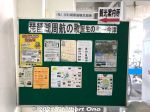
"Birthplace of Biwako Shuko no Uta" (Lake Bwa Rowing Song) on a bulletin board in the train station.
|
|
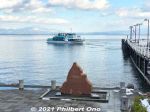
You can also get to Imazu by boat from Chikubushima island. Imazu Port has boats going to/from Chikubushima. On the eastern shore, Nagahama and Hikone have boats going to Chikubushima.At Imazu Port, boat named "Interlaken" operated by Biwako Kisen cruises to/from Chikubushima.
|
|
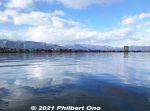
You can therefore traverse northern Lake Biwa between Nagahama/Hikone and Imazu via Chikubushima. Approaching Imazu by boat.
|
|
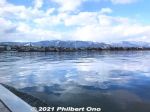
This is Imazu as the boat approaches Imazu Port. Small, quiet town anchoring the northwestern part of the lake. Tourist base for exploring this part of Shiga and the lake.
|
|
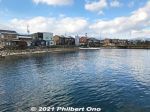
Near Imazu Port.
|
|
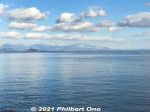
From Imazu Port, Chikubushima island and Mt. Ibuki can be seen across the lake.
|
|
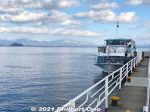
"Interlaken" cruise boat at Imazu Port with Chikubushima and Mt. Ibuki in the background.
|
|
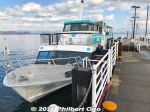
"Interlaken" cruise boat at Imazu Port.
|
|
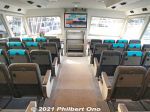
Inside Interlaken.
|
|
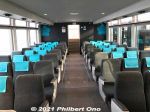
Inside Interlaken. The boat also has an outside deck.
|
|
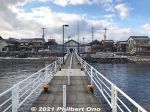
Imazu Port dock to the port building.
|
|
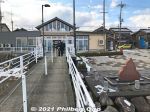
Heading to the new Imazu Port building. On the right is the Biwako Shuko no Uta (Lake Biwa Rowing Song) song monument.
|
|
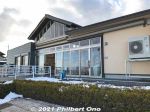
Rear view of Imazu Port building. Rebuilt and opened on March 22, 2020.
|
|
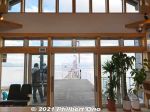
Imazu Port's gate to the boat dock.
|
|
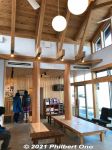
Waiting room inside Imazu Port building.
|
|
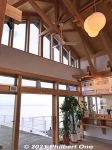
Imazu Port building is made of wood from Shiga.
|
|
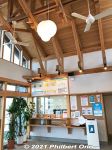
Boat ticket office.
|
|

Boat ticket office operated by Biwako Kisen.
|
|
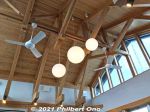
Ceiling.
|
|
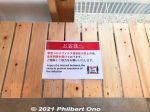
Social distancing on benches, but bad English. よい子のみなさん、この英語はダメですよ。無視してください。
|
|
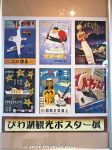
Old tourist PR posters for Lake Biwa. Great design. They don't make them like that anymore.
|
|
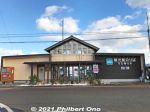
The new Imazu Port, opened in March 2020. Completely rebuilt.
|
|

This is the old Imazu Port building. It was a two-story building with a small restaurant on the 2nd floor. Ironically, it had no enclosed interior space for passengers.
|
|
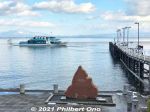
Imazu Port also has this song monument for Biwako Shuko no Uta (Lake Biwa Rowing Song). 琵琶湖周航の歌 歌碑The song is about college boys from Kyoto rowing around Lake Biwa while mentioning famous places like Otsu (the starting point), Omi-Maiko (Omatsu), Imazu, Chikubushima, Nagahama, and Chomeiji.
|
|
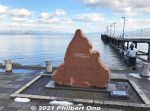
Biwako Shuko no Uta song monument at Imazu Port. In June 1917, a song called Biwako Shuko no Uta (Lake Biwa Rowing Song) was composed by college student Taro Oguchi during a boat rowing trip around Lake Biwa.
|
|

Oguchi Taro was a member of the rowing club at Dai-san High School (now Kyoto University). He composed it in Imazu, Shiga Prefecture during the second night of the trip.
|
|

The monument has an engraving of rowers and song lyrics.
|
|
|

Song monument buried in snow at Imazu Port in winter.
|
|

Song monument and snow
|
|

Imazu Port in spring.
|
|

Lake Biwa from Imazu shore. Mt. Ibuki in the distance.
|
|

Chikubushima as seen from Imazu Port
|
|

At the end of Imazu Port's dock is a lantern which is a song monument.
|
|
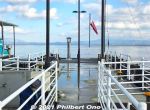
At the end of Imazu Port's dock, the lantern is a song monument for Verse 3 of Biwako Shuko no Uta (Lake Biwa Rowing Song).
|
|

The lantern is not accessible when the dock is not used.The song became a national hit in 1971 when singer Tokiko Kato recorded it. Numerous famous Japanese singers and groups have since released cover versions of the song.
|
|

The lantern/monument has the Verse 3 lyrics mentioning a red fire on shore in Imazu. This is thought to be a lamp on the dock.
|
|
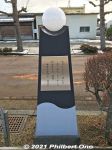
On the main road between Imazu Port and Omi-Imazu Station are sidewalk lights engraved with song lyrics. This has Verse 3 which mentions Imazu.
|
|

The main road also has this old Biwako Shuko no Uta Shiryokan (Lake Biwa Rowing Song) song museum which has closed. It moved to another building nearby.
|
|
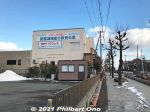
If you are walking from Omi-Imazu Station, you can see this large sign on the side of the old song museum showing the way to the relocated song museum.
|
|
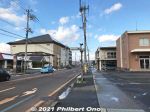
If you are walking from Omi-Imazu Station on the main road, turn left.
|
|

The new Biwako Shuko no Uta Shiryokan (Lake Biwa Rowing Song) song museum is now in this building since April 1, 2020. This is the Imazu-Higashi Community Center (今津東コミュニティセンター).
|
|

The Imazu-Higashi Community Center (今津東コミュニティセンター) is across from the Imazu Shimin Kaikan concert hall.
|
|
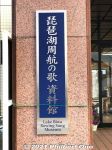
The museum sign includes English! Official English name is "Lake Biwa Rowing Song Museum."
|
|
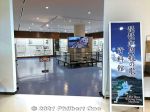
The new museum occupies a large corner of the building's first floor. It's on the left when you enter the building.
|
|

The museum has only one room in a square layout with glass cases and exhibits. The middle has a small showcase as well.
|
|
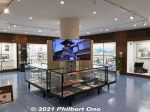
It seems all or almost all the exhibits in the old museum have been moved to this new space.
|
|
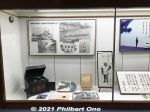
Photos of Imazu in 1917.
|
|
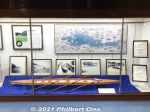
The accurate scale model of a fixed-seat boat is also displayed.
|
|
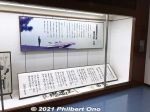
About the song lyrics.
|
|
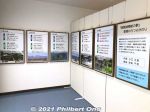
Song lyrics for all six verses.
|
|

Exhibit for Oguchi Taro who composed the song.
|
|

Exhibit for Yoshida Chiaki, credited for composing the original melody.
|
|
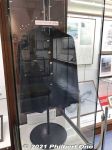
Uniform of the Dai-sanko college where Oguchi Taro studied.
|
|
|
|
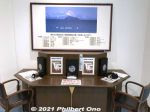
CD listening station where you can listen to numerous cover versions of the song by famous artists.
|
|
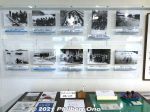
Photos of the Kanazawa college rowers who died due to strong winds that capsized their boat in 1941.
|
|
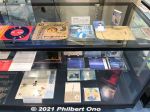
Old records of the song.
|
|
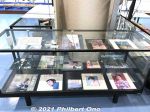
Old records of the song covered by many famous Japanese singers.
|
|
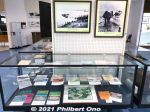
Display of Biwako Shuko no Uta calendars featuring the kirie works of ??.
|
|

A few old parts from a lake cruise boat. Compass, lamp, and other things.
|
|
|
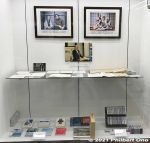
Showcase dedicated to the works of the late song researcher Iida Tadayoshi who spent many years researching the song from the 1970s. His books and booklets about the song greatly contributed to the understanding of the song, how it was created, and the people behind it.
|
|
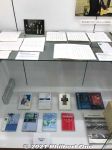
Iida donated his notebooks and cassette tapes of many interviews related to the song. Some of it is displayed here.On the lower shelf are books about the song by Iida and others.
|
|
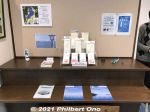
Unlike the old museum, the relocated museum does not have a gift shop. However, it does sell these stationary.
|
|
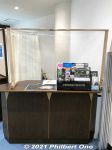
The museum is staffed by volunteers unlike the old museum which was staffed by employees from the local tourist office.Also see my blog post about the museum: https://shiga-ken.com/blog/2022/01/lake-biwa-rowing-song-museum/
|
|

From 1997 to 2019, Imazu held the annual Biwako Shuko no Uta (Lake Biwa Rowing Song) choir contest in June at Imazu Shimin Kaikan concert hall. (Discontinued after 2019.)「琵琶湖周航の歌」音楽祭合唱コンクール
|
|

Held annually in June since 1997, this choir contest has over 20 choirs, mainly from western Japan, competing for cash prizes. Takashima Shimin Kaikan Hall, venue of the choir contest. Near Omi-Imazu Station on the Kosei Line. 高島市民会館
|
|

In 2007, 25 choirs, mainly from Shiga and neighboring prefectures, competed. They sang the same song in various ways.
|
|

To enter the choir competition, the choir must have at least 12 members. The entry deadline is late Feb. Entry fee is 5,000 yen per choir (3,000 yen for high school and younger choirs).
|
|

Each choir has to sing two songs: One is Biwako Shuko no Uta, and the second one could be any song. Each choir must sing both songs within 8 min.
|
|

The choirs sing the same song in various ways. Most of them also had a piano player. The choir competition lasted from 10 am to 4 pm.
|
|

During the choir contest, Imazu Jr. High rowing club offered rides on a wooden, fixed-seat boat. It is a replica of the boat used 90 years ago by Oguchi Taro and crew.
|
|
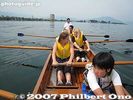
We rowed for about 20 min. Great fun, but they don't offer this boat ride anymore during the choir contest. Probably due to the lack of demand. 今津中学校ボート部がフィックス艇の体験乗船もやって面白かった。
|
|

Imazu's main lakeshore road leads to more tourist sights.
|
|

Lakeshore road in winter
|
|
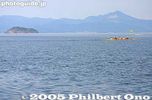
Chikubushima and Mt. Ibuki as seen from Imazu.
|
|

Imazu in winter
|
|

Imazu has a pebble beach. Some sand as well.
|
|
|

On the shore is a small stone wall and foundation, the remains of the Kaga Clan's magistrate's office. Imazu was within the Kaga domain (centering on Ishikawa Prefecture) during the Edo Period.
|
|
|

About the remains of the Kaga Clan's magistrate's office.
|
|
|

Black kite going fishing トビ
|
|
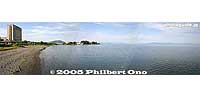
Lake Biwa shore in Imazu, with a boat landing in the distance
|
|

On Imazu's lakeshore road, Chojiya ryokan. From the roadside, it looks like a small building, but it has much depth toward the lake shore. 丁子屋
|
|

Inside Chojiya. Very impressive Japanese-style inn with lake views. This ryokan is also well-known for duck dinners.
|
|

Japanese-style room in Chojiya ryokan. Very quaint and quiet place fronting the lake.
|
|

Inside Chojiya.
|
|

Imazu also has a few buildings designed by William Merrell Vories like this former bank building in Imazu, Shiga Now a coffee shop and exhibition space. MAP
|
|

Inside the former bank building
|
|
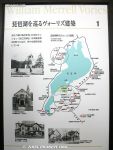
William Merrell Vories architecture map of Shiga.
|
|

Former bank building
|
|
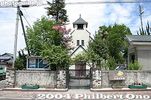
Imazu Church, designed by William Merrell Vories. Next to the former bank building also designed by Vories.
|
|

Sumiyoshi Jinja Shrine 住吉神社
|
|

Road from Imazu Port to Omi-Imazu Station.
|
|

In winter, road toward Imazu Port
|
|

Entrance to grove of Eastern Skunk Cabbage (zazenso). This is too far to walk from the train station, so you'll need a car to get here. 座禅草
|
|

Imazu is also noted for zazenso Eastern Skunk Cabbage flowers blooming in Feb. and March.
|
|

Eastern Skunk Cabbage flowers 座禅草
|
|

These flowers actually generate heat, so if it's a snowy ground, the snow around the flower would be melted.
|
|

Eastern Skunk Cabbage flower 座禅草
|
|

Eastern Skunk Cabbage flower 座禅草
|
|

Path through the grove of Eastern Skunk Cabbage flowers 座禅草
|
|

Confection in the shape of Eastern Skunk Cabbage flowers
|
|

View of Imazu from Imazu Sun Bridge Hotel, Imazu's highest building.
|
|

View of Imazu from Imazu Sun Bridge Hotel.
|
|

View of Imazu shore from Imazu Sun Bridge Hotel. 今津サンブリッジホテル
|
|

Omi-Imazu Station on JR Kosei Line, East Exit
|
|

Inside Omi-Imazu Station
|
|

In front of Omi-Imazu Station, East Exit
|
|
|

Omi-Imazu Station, west exit has bus stops for local buses.
|
|

Omi-Imazu station, west side
|
|

Omi-Imazu Station, west side
|
|
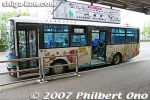
Bus at Omi-Imazu Station with localized design.
|
|

If you look closely, you can things that Imazu is famous for, like zazenso Eastern Skunk Cabbage flowers.
|
|

There's also a line from Biwako Shuko no Uta (Lake Biwa Rowing Song). My kind of bus.
|
|

Shopping arcade on the west side of Omi-Imazu Station
|
|

Shopping arcade
|
|

Scenic water on sunny day, Takashima
|
|
|
|

Biwako Shuko no Uta Birthplace Monument, Imazu. This is Imazu's second monument for the song. 全歌詞碑の「琵琶湖周航の歌」誕生の地 今津。今津港。背景には竹生島行きの船。Imazu has two monuments for the song. The first one is a lamp at the end of the pier (visible in this picture on the right of the boat). That was for Verse 3 which is written on the lamp post.
Later in 1994, Imazu town built this red clay monument to commemorate the song's birth in Imazu. The entire lyrics is also engraved. It is next to the Imazu boat pier where boats depart for Chikubushima. Looks like a red flame, but it's shaped after the geographical shape of Imazu town.
From Imazu, you can easily go to Chikubushima island, from which you can take another boat to go to Hikone or Nagahama. Going vice versa is possible too. It's a great way to cross the lake.
See more photos of Imazu here.
|
|

Old Imazu Port. Notice the "red flame" song monument on the right.
|
|

Model of fixed-seat boat used during Oguchi Taro's time in 1917.Model of the fixed seat boat that Taro Oguchi and crew used to row around Lake Biwa. Displayed at the song museum in Imazu. The boat is quite stable and thus suited for long rowing trips. However, it became obsolete in the 1960s as competitive rowing boats incorporated sliding seats.
In 1993, a boat craftsman built two of these and donated them to Imazu. They measure 13.7 meters long and 1.25 meter wide. Seats 6 crew. They are available for rent at Imazu.
|
|

Model of fixed-seat boat, Biwako Shuko no Uta Shiryokan museum
|
|

Model of fixed-seat boat
|
|

Biwako Shuko no Uta Shiryokan (Lake Biwa Rowing Song Museum), Imazu 琵琶湖周航の歌資料館The museum has various panel exhibits, videos, etc. Currently, no explanations in English. Tokiko Kato scored a national hit with the song in 1971.
|
|

Biwako Shuko no Uta Shiryokan (Lake Biwa Rowing Song Museum), Imazu 琵琶湖周航の歌資料館
|
|

Listening corner list of cover artists. There are many, and you can listen to each of them. Biwako Shuko no Uta Shiryokan (Lake Biwa Rowing Song Museum), ImazuThe song was included in a record for the first time in 1958 when Kyoto University made an album of its university songs on the 90th anniversary of the school's founding. In 1961, a chorus group named Boney Jacks recorded the song in an album of Japanese songs. And so did singer Peggy Hayama in 1962.
|
|

Panel exhibits of each verse.
|
|

Panel showing Japanese lyrics, old and new. Biwako Shuko no Uta Shiryokan, ImazuOne of the exhibition panels with the song lyrics showing all the little quirks and idiosyncrasies of the words. This is the first verse.
|
|

Oguchi Taro exhibit.
|
|
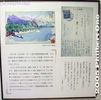
Handpainted postcard from Taro Oguchi mailed from Imazu on June 28, 1917.During the rowing trip, Oguchi wrote a postcard to a friend back at the school dorm in Kyoto. One side of the card has his watercolor painting of Omatsu with pine trees on the sandy beach and a boat pier. Oguchi was quite good at painting.
Oguchi sent the postcard from Imazu on June 28, 1917, in the evening sometime between 9 pm and midnight after arriving from Omatsu. He sent it to a friend named Hiroshi Kodama back at the school dorm in Kyoto. However, the friend never received the postcard since he was back in his hometown in Niigata Prefecture for the summer.
The postcard was returned to Oguchi who kept it. If his friend had received the postcard, he would have certainly thrown it away (as he later mentioned in an interview). This postcard has survived miraculously and it is key evidence for the exact date when they were in Imazu where the song was created.
On the postcard, Oguchi writes about how easy it was to row to Omatsu the day before, thanks to a strong tailwind. He notes that Omatsu was a lonely place with only one lodge. They tied up the boat in the pond and rolled around on the sand till late night while gazing at the moon and dreaming of a beautiful girl. That morning, they played tug of war (it was fun). He also mentions that they were to lodge in Imazu that night.
|
|

Old records by famous Japanese singers and groups who covered the song.
|
|

Outdated photo: Arriving Imazu Port. This old port building was replaced by new building in March 2020. MAP
|
|

Outdated photo: Red flame monument for Biwako Shuko no Uta song 琵琶湖周航の歌 歌碑
|
|

Outdated photo: Waiting lounge at Imazu Port in winter.
|
|
|

The old Biwako Shuko no Uta Shiryokan (Lake Biwa Rowing Song Museum), dedicated to the Lake Biwa Rowing Song, Shiga's most famous song. 琵琶湖周航の歌資料館 MAPThis old museum closed in March 2020, and moved to the Imazu-Higashi Community Center on April 1, 2020. Museum photos on this page show the old museum.
Photos of the new museum is here: https://shiga-ken.com/blog/2022/01/lake-biwa-rowing-song-museum/
In June 1917, a song called Biwako Shuko no Uta (Lake Biwa Rowing Song) was composed by college student Taro Oguchi during a boat rowing trip around Lake Biwa. He was a member of the rowing club at Dai-san High School (now Kyoto University). He composed it in Imazu, Shiga Prefecture during the second night of the trip.
|
|

Inside the old song museum.The song is about the boys rowing around Lake Biwa while mentioning famous places like Otsu (the starting point), Omi-Maiko (Omatsu), Imazu, Chikubushima, Nagahama, and Chomeiji.
|
|

Another boat mate matched Oguchi's lyrics to the melody based on the old song called Water Lilies as modified by a young Chiaki Yoshida.It soon became a popular dormitory song. The song became a national hit in 1971 when singer Tokiko Kato recorded it. Numerous famous Japanese singers and groups have since released cover versions of the song. The town of Imazu even holds an annual song contest in June when choir groups from around Japan sing the song in a competition. The town even has this museum dedicated to the song.
|
|

Song museum's listening station where you can listen to many cover versions of the Lake Biwa Rowing Song recorded by Japanese singers and groups.
|
|

List of cover versions by singers like Miyako Harumi, Kobayashi Akira, Watari Tetsuya, Baisho Chieko, Frank Nagai, and more.
|
|
|

Made of wood. The seats do not move. It is an obsolete racing boat.
|
|

Pictures of Lake Biwa Rowing Song monuments in Shiga. One for each of the six verses in the respective locations mentioned in the song.
|
|
|

Exhibit about Oguchi Taro who created the song.
|
|

Exhibit about Yoshida Chiaki who composed the original melody.
|
|
|
|
|

Records of the song by various artists including Tokiko Kato.
|
|

Comments about the song are welcome.
|
|

Souvenirs also sold in the museum.
|
|

Water lilies from the Niigata home of Chiaki Yoshida who composed the melody of Lake Biwa Rowing Song. From the original plant that Chiaki planted.
|
|
|
|

Water lilies
|
|

In the old Imazu Port building, snowy seats in winter.
|
|
|
|
|